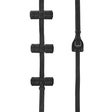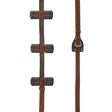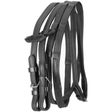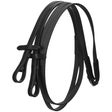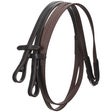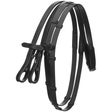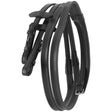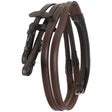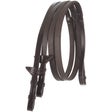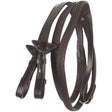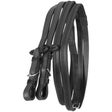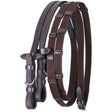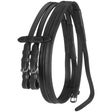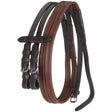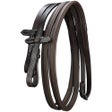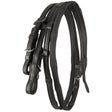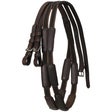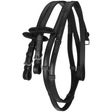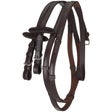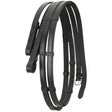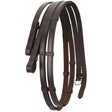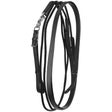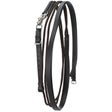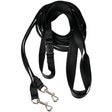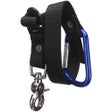Types of English Reins
& How to Measure
No matter what kind of bit or bridle is used, we communicate with our horses through the reins first and foremost. Learning to communicate quietly yet effectively not only takes time, but also strong balance, crisp aids, and a giving hand. This is already a tough task, and ill-fitting equipment or a rein style that does not feel right to you will only make communicating with your horse more difficult. It is important to use well-fitting tack to help set you and your horse up for success!
English reins come in a variety of styles and sizes, which can make the search for the right set of reins challenging. Depending on the needs and preferences of the rider, there are a multitude of options! Material, design, and length all play a role in finding the ideal pair of reins to connect your hand aids to the horse. Follow along as we compare the various types of English reins, as well as how to measure them. This comprehensive guide is meant to clarify any confusion you may have regarding English reins, so that you can feel better equipped to pick the best option for you!
Rein Considerations

Rein types from left to right: training reins, rubber reins, combination reins, web rubber reins, braided leather reins, smooth leather reins.
If you are searching for reins to match your current bridle, there are a few important factors to consider. While there are no rules saying your reins and bridle have to match, a cohesive tack set presents an overall professional look. Most reins come in black and brown to match dressage bridles and hunter/jumper bridles respectively. The color of the hardware metal can also vary, with brass and stainless steel being the most common. Make sure to look at what color metal is on your current bridle or on the bridle you are considering purchasing. Lastly, reins connect to the bit with either a buckle or hook-and-stud closure. The buckle design points outward, whereas the hook-and-stud design is meant to face inward. Just like the previous considerations, this is an aspect that can be matched with your bridle.
Types of English Reins

Leather rein types, going from left to right: braided leather reins, smooth leather reins.
Leather
Considered to be the most popular material, there are tons of leather reins on the market. Leather reins provide a more classic look and are a great option to match tack with without losing any functionality. Leather reins offer fewer variations in thickness but do come in many widths. Leather reins can come in different designs such as braided, flat, and with stops. These styles affect the feel of the reins and are solely based on rider preference. That said, braided reins are often viewed as the most traditional looking and are well received in the hunter ring. Leather reins can be solely leather or can feature fancy stitching near the bit attachment for extra style.

Rubber and web rein types, going from left to right: training reins, rubber reins, and web rubber reins.
Web
Similar to rubber reins in grip, but with a fabric look and feel, web reins are another common rein style. Made from woven rubber and nylon fibers, these reins are comfortable to hold and nonabrasive. Web reins, such as the Schockemoehle DuraSoft Web Rein, often feature external leather stoppers to help keep a consistent rein length.
Rubber
Rubber reins often have segmented portions that give riders an easy way to maintain their desired length. Some are sectioned by external stoppers, like the Schockemoehle Rubberized Bridle Reins. Others have dividers integrated into the reins for a seamless appearance, such as the Schockemoehle DuraSoft Leather Rubber Grip Reins.
There are also rubber reins with no sections, which are designed for riders who find a continuous rein like the Schockemoehle Rubber Reins more comfortable. Rubber reins are offered in a variety of thicknesses and flexibility levels depending upon the manufacturer. These differences are mainly for personal preference; choose whatever feels good in your hands!

Leather & Rubber Hybrid (Combination) Reins
If you love the feel of rubber reins but not the look, there are combination options that have a leather exterior and a rubber interior, like the Collegiate One Sided Rubber Grip Inside Reins. These reins can give you the extra grip that may be lacking in pure leather reins. These reins also come with stopper variations, either on the outside or integrated into the rein.
Lunging & Training Reins
In addition to bridle reins, there are training reins that can be used in conjunction with or separately from your typical schooling rides. Side reins are used when lunging and replicate consistent hand-to-mouth contact when no rider is present, like the Passport Elastic Side Reins by Toklat. There are many equipment additions for lunging, so be sure to check out all of our lunging equipment!
Draw reins are another training tool riders can use. They connect to either the center of the horse's girth or the sides of the girth below the saddle flap to encourage the horse to reach down and out to the contact. Draw reins act as a pulley system in the horse's mouth and should only ever be used on a snaffle bit and in conjunction with your regular reins.
Special Considerations
Reins for Beginners
We suggest the Kincade Rainbow Rubber Reins for the beginner English rider just starting out, as they help provide a concrete understanding for maintaining rein length. Perfect for riders who are learning to have a consistent hand, the color blocks create a quick visual tool that the rider and trainer can rely on. In addition to the fun and distinct colors, the rubber pimple texture makes these reins suitable for riding in any type of weather!
Curb Reins
Exclusively offered in leather, curb reins like the Schockemoehle Curb Rein are specifically designed for pelham and curb bits. Curb reins provide a secondary leverage option to the snaffle bit that can be idle when need be. Curb reins are much narrower than snaffle reins at ½ inch, compared to ⅝ or ¾ inches; this allows the rider to feel a distinct difference while holding multiple sets of reins in hand.
If you and your horse find that a pelham or double bridle is the best option, but two reins are too much to manage, a bit converter is an option. Bit converters, like the Camelot bit converter, connect the two rein ports to make one connection point for your reins. However, do be aware that a bit converter will affect the overall functionality of your bit by taking away the curb's idle ability.

English Rein Sizing
Once you've decided on the kind of reins you want, the next step is figuring out the length needed. Reins are measured from the bit end to the buckle or wither point in the middle. English reins commonly come in pony, cob, horse, and oversized options. As there are no industry standards for rein length and their associated size names, we always recommend looking at the actual product measurements for reference. English rein lengths are generally offered as follows:
| Pony | Cob | Horse/Full | Oversize |
| 48" | 52" | 54" | 60" |
Frequently Asked Questions
Q: Why do some dressage riders use double reins?
A: Starting at the CDI3* level in pure dressage, a double bridle must be used on the horse. A double bridle gives a rider more tools when communicating with their horse. The snaffle/bradoon bit is meant for lateral direction, whereas the curb bit is for longitudinal directions and collection. By having two separate reins on a curb bit in a double bridle, the rider is able to be more specific in their hand aids to the horse.
Q: How long should my reins be?
A: Having reins that are too short or too long can not only be an inconvenience to the rider but also a safety hazard. If your reins are too short, they are at risk of getting away from your hands too quickly in the case of a problem. Should your reins be too long, the likelihood of your hands getting tangled in the excess rein increases, putting both you and your horse in a predicament. Your reins should be long enough to let your horse fully extend its neck out while still providing you a comfortable hold.
Q: What width of rein do I need?
A: Ultimately, choose whichever width feels best in your hand. A rider with larger hands might appreciate a thicker set of reins, and vice versa for riders with smaller hands. Pony and cob reins commonly come in a 5/8" width, while horse and oversized reins typically come in a 3/4" width. Some riders prefer to have less in their hand and might opt for a thinner rein. Curb reins are always 1/2" wide to provide the rider with a distinct difference between the two sets of reins; this way, the user can rely on feel rather than sight to distinguish which rein is which.
Closing Thoughts

We hope you feel better informed about the different types of English reins, so you can more easily navigate the options. Keep in mind that the sizing recommendations we addressed are simply recommendations. At the end of the day, the goal is to use well-fitting tack that works for you and your horse! If you are feeling unsure about your tack, running any changes by a coach or trainer is a smart idea that could save you time, effort, and money. Should you have any further questions on English reins, feel free to contact our helpful customer service team at 1-800-620-9145 or info@ridingwarehouse.com for assistance. Ride on!
| Shop All English Reins |
